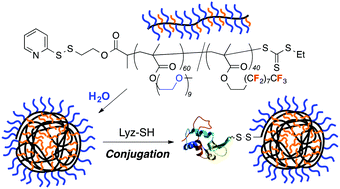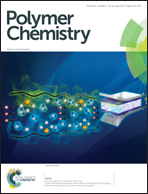Amphiphilic/fluorous random copolymers as a new class of non-cytotoxic polymeric materials for protein conjugation†
Abstract
Herein, amphiphilic/fluorous random copolymers bearing poly(ethylene glycol) (PEG) chains and perfluorinated alkane pendants were developed as novel non-cytotoxic polymers for protein conjugation. Three kinds of random copolymers with different initiating terminals (carboxylic acid, pyridyl disulfide, and N-hydroxysuccinimide ester) were prepared by reversible addition–fragmentation chain transfer (RAFT) copolymerization of a PEG methyl ether methacrylate and a perfluorinated alkane methacrylate with the corresponding functional chain transfer agents. All of the polymers were soluble in water to form nanostructures with perfluorinated compartments via fluorous interaction: large aggregates from the intermolecular multi-chain association and compact unimer micelles from the intramolecular single-chain folding. Such a PEGylated and perfluorinated random copolymer was non-cytotoxic to NIH 3T3 mouse embryonic fibroblast cells and human umbilical vein endothelial cells (HUVECs). Additionally, a random copolymer with a pyridyl disulfide terminal was also successfully conjugated with a thiolated lysozyme.

- This article is part of the themed collection: Celebrating The Five-Year Anniversary of Polymer Chemistry

 Please wait while we load your content...
Please wait while we load your content...